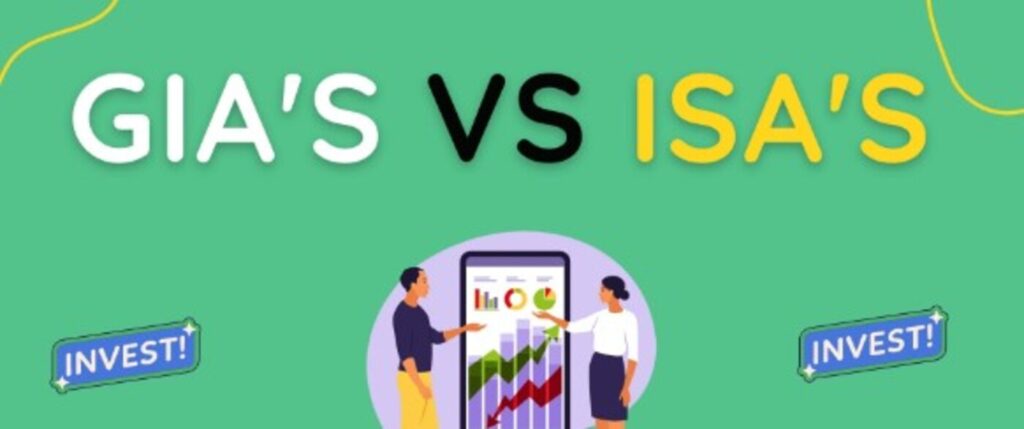ISAs
General investment account vs ISA: How Should You Invest?

Trying to figure out whether a General Investment Account (GIA) or an Individual Savings Account (ISA) suits your needs can feel like staring at a tangled web of rules, fees, and tax jargon. You just want to grow your money in the smartest way possible without worrying about accidentally inviting HMRC to take a chunk of your returns.


And it's not just GIA vs ISA that causes confusion—many people also get stuck comparing a Stocks and Shares ISA vs Cash ISA, unsure which offers better returns or suits their risk tolerance.
However, if today the Stocks and Shares ISA vs General Investment Account debate has left you frustrated, you’re not alone. Let’s break it down properly and finally give you some clarity.
What is a GIA?
If you’ve maxed out your ISA allowance or just want no restrictions on how much you can invest, a General Investment Account might sound like the answer. GIAs are like the open playground of investing, flexible and limitless. You can hold shares, bonds, funds, ETFs, and whatever you like, whenever you like.
But GIAs don’t come with a tax-free safety net. Once your earnings breach certain thresholds, you’re liable for capital gains tax and dividend tax. And with tax-free allowances dwindling, dropping to £3,000 for capital gains next year and £500 for dividend income, it’s easy to get stung by a hefty bill.
If your portfolio’s doing well, great!
But it’s also a double-edged sword because the more you earn, the more tax you might owe and that’s a stress you probably don’t want hanging over your head, especially if you’re someone who’s just getting their feet wet in the investing world and doesn’t want to worry about surprise bills.
So, why would anyone pick a GIA?
Because it’s flexible. You can invest as much as you like, whenever you want. If you’re someone who’s already maxed out your ISA allowance and has cash to spare, a GIA offers the freedom you need to keep going. Yet, freedom without guidance can be risky, especially when the taxman’s lurking.
What is an ISA?
On the other side, you’ve got ISAs, specifically, Stocks and Shares ISAs, which are basically built to keep your investments safe from tax headaches. For most people, the appeal is obvious: whatever you make inside your ISA is completely tax-free, whether it's from dividends, interest, or capital gains.
The government gives you a £20,000 annual allowance, which is usually enough for most people’s investments. And once your money’s in, it grows tax-free forever. It’s simple, straightforward, and keeps you from having to fill out extra tax forms, a big plus if you’re someone who hates admin as much as the next person.
The rub, however, is the £20,000 limit. If you’re someone who’s hitting that ceiling or dreams of building a big enough portfolio to retire early, it’s frustratingly restrictive. Even if you’re playing within the limits, there’s still the fear of not using your allowance effectively.
Should you split it between different ISAs? Should you focus on the best Stocks and Shares ISAs over other types? The choices can feel endless.
GIA vs ISA Differences
Comparing a Stocks and Shares ISA vs General Investment Account is all about figuring out which frustration you’re more willing to live with: tax limitations or investment limitations. And it comes down to a few key factors:
- Tax efficiency: ISAs are unbeatable here. As long as you stay within your £20,000 annual allowance, all your gains are yours to keep tax-free. General Investment Account tax, however, leave you exposed to capital gains tax and dividend tax once you break through the increasingly tighter allowances.
- Investment limits: ISAs are great until you hit the cap. With GIAs, the sky’s the limit. If you want to invest £100,000 this year, you can go ahead, but must be prepared to face the taxman when your profits roll in.
- Flexibility: GIAs offer unlimited contributions and withdrawals without affecting your allowances. But ISAs are simple, set it and forget it, without having to stress over tax calculations or keeping track of allowances.
- Access to funds: Both are flexible in terms of withdrawals, but ISAs can get tricky if you’re dealing with nonflexible versions where withdrawals count against your annual limit.
In practice, most investors aren’t sticking to just one. They’re using ISAs to shield their gains from tax and GIAs to invest above their annual allowance.
Pros and Cons
GIA
| Pros of GIA | Cons of GIA | ||
| ✅ No limits: Invest as much as you like—no annual cap. | ❌ Taxable: Gains over the annual capital gains tax allowance (£3,000 for 2025/26) are taxable. | ||
| ✅ Flexible withdrawals: Take money out anytime, with no penalties. | ❌ Income tax: Dividends and interest may be subject to income tax if they exceed your allowances. | ||
| ✅ Good for overflow: Useful if you’ve already maxed out your ISA allowance. | ❌ More admin: You’ll need to report gains and income to HMRC if they exceed thresholds. |
| Pros of GIA | Cons of GIA |
| ✅ No limits: Invest as much as you like—no annual cap. | ❌ Taxable: Gains over the annual capital gains tax allowance (£3,000 for 2025/26) are taxable. |
| ✅ Flexible withdrawals: Take money out anytime, with no penalties. | ❌ Income tax: Dividends and interest may be subject to income tax if they exceed your allowances. |
| ✅ Good for overflow: Useful if you’ve already maxed out your ISA allowance. | ❌ More admin: You’ll need to report gains and income to HMRC if they exceed thresholds. |
ISA
| Pros of ISA | Cons of ISA | ||
| ✅ Tax-free: No income tax or capital gains tax on profits. | ❌ Contribution limits: You can only invest up to the annual allowance each year. | ||
| ✅ Flexible options: Choose from Cash ISAs, Stocks & Shares ISAs, Lifetime ISAs, etc. | ❌ Some restrictions: Lifetime ISAs have age and withdrawal rules; Cash ISAs may have lower returns. | ||
| ✅ No reporting: You don’t need to declare ISA income or gains to HMRC. | |||
| ✅ Encourages long-term saving: Annual allowance incentivises strategic investing (£20,000 in 2025/26). |
| Pros of ISA | Cons of ISA |
| ✅ Tax-free: No income tax or capital gains tax on profits. | ❌ Contribution limits: You can only invest up to the annual allowance each year. |
| ✅ Flexible options: Choose from Cash ISAs, Stocks & Shares ISAs, Lifetime ISAs, etc. | ❌ Some restrictions: Lifetime ISAs have age and withdrawal rules; Cash ISAs may have lower returns. |
| ✅ No reporting: You don’t need to declare ISA income or gains to HMRC. | |
| ✅ Encourages long-term saving: Annual allowance incentivises strategic investing (£20,000 in 2025/26). |
How to invest with a GIA or ISA
Pick an Investment Platform
Choose a trusted app or website to invest through. Some popular ones include:
Compare their fees and how easy they are to use.
Choose Your Account Type
- ISA – Tax-free investing (you can put in up to £20,000 per tax year).
- GIA – No limit on how much you invest, but you may pay tax on profits.
You can open either (or both) with most platforms.
Set Up Your Account
You’ll need to give:
- Your name and address
- National Insurance number
- Photo ID (passport or driving licence)
It usually takes just a few minutes online.
Add Money
- ISA: Up to £20,000 per tax year (2025/26)
- GIA: No limits — invest as much as you want
You can add funds by bank transfer or debit card.
Choose What to Invest In
You can invest in:
- Company shares
- Index funds or ETFs
- Bonds or other assets
- Ready-made portfolios (great for beginners)
Most platforms help guide you if you're not sure.
Keep an Eye on Your Investments
- Check performance every now and then
- Make changes if your goals or the market change
- Use your ISA first to avoid tax
Can you have a GIA and Stocks and Shares ISA?
Absolutely, you can hold both a General Investment Account (GIA) and a Stocks and Shares ISA at the same time. There’s no restriction on having both, and many investors choose to use them side by side depending on their goals.
For example, you might use your ISA for tax-efficient investing up to the annual limit, and then continue investing through a GIA once that allowance is used. Both accounts can usually be managed from the same investment platform, making it easy to track your portfolio in one place.
GIA vs ISA: Which one is right for you?
This depends on what’s eating away at you most. Is it the fear of missing out on tax-free gains? Or the worry that your investments will hit a hard cap just when you’re starting to gain momentum?
If you’re after simplicity, hassle-free growth, and the comfort of knowing HMRC can’t touch your returns, then an ISA is a clear winner. If you’re in a position to invest more than £20,000 a year, or you’re building a high-value portfolio, a General Investment Account can be a powerful tool to keep pushing forward.
The smartest investors know that you don’t have to pick sides. Filling up your ISA allowance first and then putting the rest into a GIA lets you enjoy the best of both worlds. Tax-free gains where they matter most and unrestricted investing when you’re ready to take things to the next level.
FAQs
Can I transfer a GIA to an ISA?
No, you can’t directly transfer investments from a GIA to an ISA. You’d need to sell the assets in your GIA, transfer the cash to your ISA, and then reinvest. Be mindful of capital gains tax when selling assets.
Do I declare ISA gains on tax returns?
No, you don’t. Gains made within an ISA, whether from dividends, interest, or capital growth, are entirely tax-free and don’t need to be reported on your tax return.
Can I hold multiple GIAs or ISAs?
You can open multiple GIAs at any time. When it comes to ISAs, many people ask: how many ISAs can I have? The answer is that you can hold multiple ISAs across different types—such as a Cash ISA, Stocks and Shares ISA, Lifetime ISA, and Innovative Finance ISA. However, you can only contribute to one of each type per tax year, and just one Stocks and Shares ISA within the same tax year.
Do GIAs or ISAs have fees?
Yes, both can come with fees, including account management charges, transaction fees, and fund management costs. ISAs may also have platform fees depending on the provider. Always compare costs before investing.
What happens to a GIA or ISA if I pass away?
ISAs lose tax-free status; GIAs may face inheritance tax.